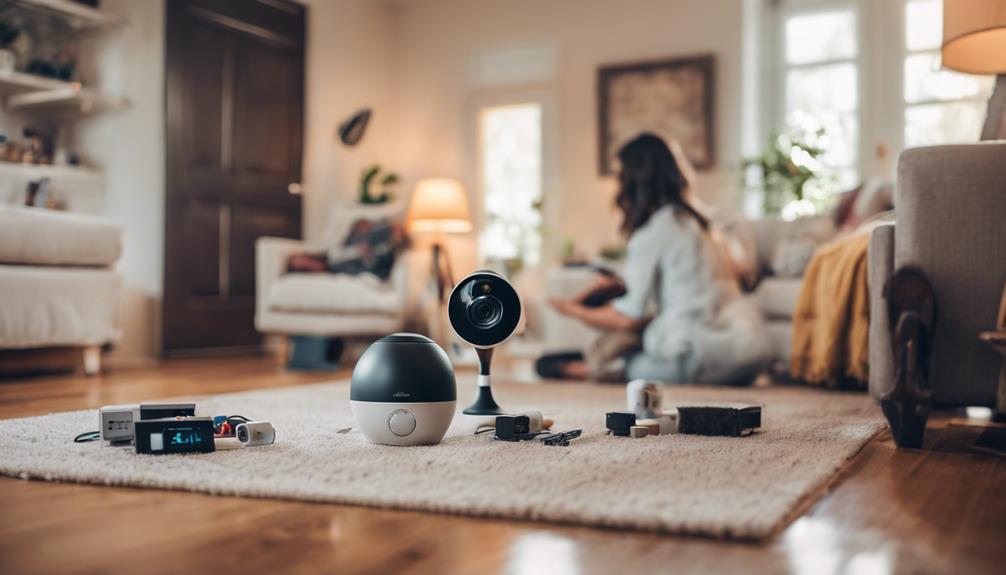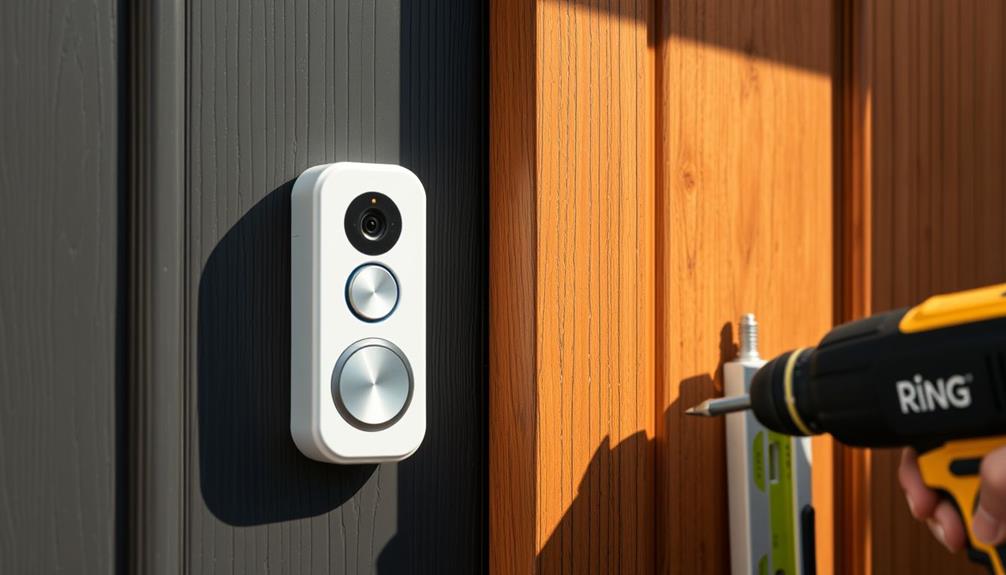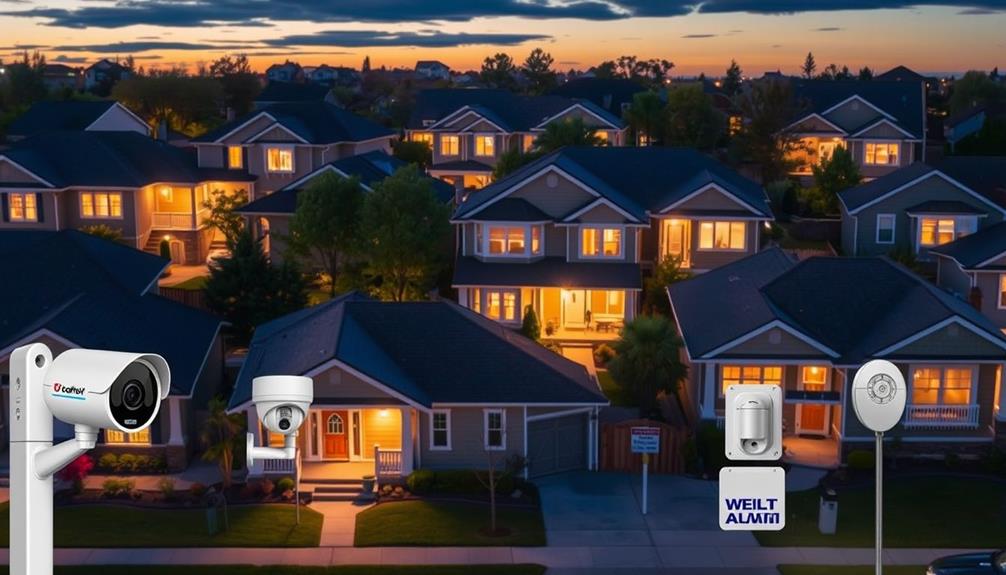To install your SimpliSafe home security system, start by reviewing the setup guide and selecting a good spot for the base station, ideally far from light switches. Then, download the SimpliSafe app to your smartphone for step-by-step instructions. Connect the base station to power and your 2.4 GHz Wi-Fi network. Next, place sensors on doors and windows, following the app's guidance. Activate the sensors, name them for easy access, and set up monitoring options through the app. It's a simple DIY process that offers flexibility, but more tips and tricks await you as you move forward. Don’t forget to test your system to ensure everything is working properly. SimpliSafe also offers additional home security system options, such as cameras and smoke detectors, if you want to expand your coverage. With the ability to customize and add on to your system, you can further enhance the security of your home as needed.
Key Takeaways
- Review the SimpliSafe setup guide and plan sensor placement for optimal security coverage before installation.
- Connect the base station to a power outlet, download the SimpliSafe app, and follow prompts for setup.
- Install entry sensors on doors and windows at 4-5 feet, and motion sensors in high corners, avoiding direct sunlight.
- Confirm device functionality through the app after removing battery tabs and activating each sensor.
Installation Preparation
Before diving into the installation, take some time to review the SimpliSafe setup guide to familiarize yourself with the process and component placement. This guide is vital for understanding where to position your base station, keypad, and sensors effectively.
You'll want to choose a suitable location for your base station, ensuring it has a dedicated power outlet away from light switches to avoid interference. Additionally, consider utilizing smart organization techniques to keep your tools and components neatly arranged during the setup.
Next, it's important to plan where you'll be placing sensors throughout your home. Think about entry points, high-traffic areas, and potential vulnerabilities to maximize your security coverage. Having this plan in place will streamline your installation process, making it more efficient.
Don't forget to download the SimpliSafe app if you haven't already. It's a valuable tool that provides step-by-step guidance to assist you during the installation. If you encounter challenges or prefer not to handle it yourself, consider professional installation—though many find the DIY approach straightforward and rewarding.
Setting Up the Base Station

Start by unpacking the base station and connecting the power cord adapter to the bottom of the device, ensuring it's plugged into a dedicated outlet away from light switches. This will keep your setup running smoothly.
Next, download the SimpliSafe app on your smartphone. Open the app and follow the prompts to initiate the setup. You'll need to name your property for easy identification.
For the next step, connect the base station to your 2.4 GHz Wi-Fi network. Make sure you see a blue light indicator on the device to verify the connection is successful.
Here's a quick reference table to help you with the setup process:
| Step | Action | Notes |
|---|---|---|
| 1 | Connect power cord | Use a dedicated outlet |
| 2 | Download SimpliSafe app | Available on iOS and Android |
| 3 | Name your property | Choose something recognizable |
| 4 | Connect to Wi-Fi | Use 2.4 GHz network |
Once everything's set up, select "Done Installing" in the app to enter practice mode, allowing you to test the system without triggering alarms. Monitor performance and adjust as necessary for peak operation.
Installing Sensors and Devices

Now that you've set up the base station, it's time to install your sensors and devices. For peak performance, consider the layout of your home and potential obstacles that could interfere with sensor functionality.
Additionally, you may want to think about what to look for in a home cleaning service before making any cleaning arrangements that could disrupt the installation process.
You'll want to follow the app instructions closely for ideal placement and verify everything is securely mounted.
Let's go over some tips for sensor placement and the steps to install each device effectively.
Sensor Placement Tips
To guarantee your SimpliSafe system works effectively, strategically place your sensors in key areas throughout your home.
Start with entry sensors; install them on all doors leading outside and on windows, ideally at a height of 4 to 5 feet for ideal detection. This positioning helps catch any unauthorized access right away. Additionally, consider enhancing your home's security with reliable options such as garage door openers that feature advanced technology and smartphone connectivity.
Next, focus on motion sensors. Place them in high corners of rooms to maximize coverage, especially in areas with high foot traffic. Avoid direct sunlight to reduce the chances of false alarms.
Don't forget about environmental sensors like smoke and CO detectors. Install these on each level of your home, ensuring they're within 10 feet of sleeping areas for enhanced safety during the night.
Using adhesive or screws to secure each sensor is essential; follow the app's recommendations for specific placements tailored to your home layout.
Device Installation Steps
Start by removing the battery tabs from each sensor and pressing the setup buttons to activate them for installation. This step is essential for your SimpliSafe system to recognize the devices.
As you initiate this process, it's also beneficial to maintain a clear energy flow in your environment, as this can enhance your focus and effectiveness during installation, similar to the benefits of unclogging energy flow for increased energy.
Next, use the SimpliSafe app to follow the step-by-step instructions for proper placement and installation of each device. The app will guide you on where to position your sensors for maximum coverage.
As you install each sensor, assign unique names to them in the app. This makes it easier to identify and manage each device within your system.
Make certain all devices are securely installed using the provided adhesive or screws; this prevents any dislodgment and guarantees reliable performance.
Once you've finished installing the sensors, return to the app to confirm that each device is ready and functioning correctly. This step verifies that your installation is complete and confirms your monitoring subscription can effectively monitor your home.
Monitoring Setup

Setting up monitoring for your SimpliSafe system involves completing the professional monitoring setup through the SimpliSafe app while choosing the right plan for your needs.
You can take advantage of the 30-day free trial for professional monitoring, allowing you to evaluate the service before committing to a monthly fee. Given the growing demand for security solutions, utilizing smart technology for home protection is becoming increasingly significant, as evidenced by the rise of AI cybersecurity jobs that focus on safeguarding digital infrastructures.
During the setup process, you'll need to input essential personal information, including your emergency contacts. This guarantees that, in case of an emergency, the monitoring center can quickly reach out to the right people.
It's also vital to save the contact numbers for the monitoring center; having immediate access to assistance can make all the difference in urgent situations.
Remember to keep track of your trial period. If you decide not to continue with the monitoring service, set a reminder to cancel the free trial to avoid any unexpected charges.
With these steps, you'll have your SimpliSafe monitoring set up and ready to provide peace of mind in protecting your home.
Comparing Installation Options

How do you decide between DIY installation and professional setup for your SimpliSafe home security system? The choice largely depends on your comfort level with technology and how quickly you want to secure your home.
With SimpliSafe's DIY installation, you can follow step-by-step guidance through the app, making it a flexible and user-friendly option. This method allows you to set up your system at your own pace and without needing professional tools. Additionally, much like understanding flushing practices that vary from region to region, being informed about your security options can enhance your installation experience.
On the other hand, if you prefer a hands-off approach, professional installation might be the way to go. Starting at $124.99, a trained technician won't only install the system for you but also connect it to Wi-Fi and provide personalized training on how to use it effectively.
What's great about SimpliSafe is the flexibility it offers. You can switch between DIY and professional installation methods without facing any penalties. This means you can start with DIY and, if you find it overwhelming, opt for professional help later.
Ultimately, it's about choosing the installation method that best fits your needs to secure your home effectively.
System Management Features

When it comes to managing your SimpliSafe system, you'll find a variety of monitoring options that fit your lifestyle.
With features like customizable alerts and real-time notifications, you can guarantee your home stays secure, even when you're away.
Additionally, consider integrating smart kitchen devices that offer convenience and connectivity to enhance your overall home management.
You can customize settings to guarantee the security features align perfectly with your daily routine.
Plus, the flexibility of the mobile app and web portal makes it easy to stay connected and in control wherever you are.
Monitoring Options Available
Exploring SimpliSafe's monitoring options reveals a range of customizable plans that cater to different security needs and budgets. As a SimpliSafe customer, you can choose between self-monitoring and professional monitoring options, guaranteeing your system aligns with your preferences.
Here's a quick comparison of the available monitoring plans:
| Plan Type | Features |
|---|---|
| Standard Plan | Basic alerts, no professional help |
| Interactive Plan | Remote access, smart home integration |
| Monthly Fee | Starts at $19.99 |
| Monitoring Center | 24/7 support available |
| Contact Options | Set primary & secondary contacts |
With the Interactive plan, you gain access to features like remote management of your system and integration with smart devices. Plus, there's no cancellation fee, giving you the flexibility to adjust as needed. Both plans guarantee you can reach the monitoring center any time, day or night, providing peace of mind. Whether you prefer a DIY installation or professional setup, SimpliSafe has you covered with reliable 24/7 professional monitoring services.
System Customization Features
SimpliSafe lets you customize your security system to fit your unique needs, whether you start with a pre-packaged kit or select individual devices. This flexibility is one of the standout features of their customizable security systems. You can easily configure your system through the mobile app or web portal, allowing you to add or remove devices as your requirements change.
During setup, you can adjust entry and exit delays, ensuring the system aligns with your daily routine. With the Panic button feature, you can send immediate emergency alerts to the monitoring center, providing peace of mind in critical situations.
Additionally, you'll appreciate the alerts and notifications that you can customize. Choose to receive timely updates via text or push notifications for any system events, keeping you informed at all times.
If you opt for video verification, you can further enhance your security by receiving real-time video feeds during alerts, allowing you to assess situations instantly. Customizing your SimpliSafe system empowers you to create a security solution tailored specifically to your lifestyle and needs.
Additional Resources

You'll find a variety of additional resources to help you navigate the installation and management of your SimpliSafe system effectively. Start by visiting the SimpliSafe website, where you can access product manuals, troubleshooting guides, and FAQs tailored for your SimpliSafe Home Security needs. These guides can be particularly useful during camera installation, making sure you follow the correct steps and procedures.
If you encounter any issues or have specific questions, don't hesitate to reach out to SimpliSafe's 24/7 customer support. They're available to assist you with any installation queries or technical problems you might face.
Additionally, consider joining community forums where you can engage with other users. These platforms allow you to share experiences and seek advice on installation challenges or best practices from fellow SimpliSafe customers.
Lastly, don't forget to utilize the SimpliSafe app. It provides step-by-step installation guidance and real-time prompts to make the setup process smoother. By leveraging these resources, you can guarantee a successful installation and ideal management of your security system.
Common Questions

As you navigate the installation process, it's natural to have some questions regarding the setup and functionality of your SimpliSafe system. Here are some common inquiries and their answers:
| Question | Answer |
|---|---|
| How do I set up the Indoor Camera? | Remove the battery tab and press the setup button. The app will guide you through pairing it. |
| What's the role of the motion sensor? | It detects movement and alerts you if there's any unusual activity. |
| How do I use practice mode? | Enable practice mode in the app to test your setup without triggering real alarms. |
Once everything's installed, remember that you can customize your home security system's modes—Off, Home, or Away—directly through the app or keypad. This flexibility allows you to adjust the settings based on your needs, ensuring you have complete control. Don't hesitate to reach out to SimpliSafe support if you encounter any issues, as they're available to help you get your home security system running smoothly.
Frequently Asked Questions
Can I Install Simplisafe Myself?
Yes, you can install SimpliSafe yourself! The user-friendly app guides you step-by-step, and you won't need any professional tools. Just follow the instructions, and you'll have your system set up quickly and easily.
How Long Does It Take to Set up a Simplisafe Security System?
Setting up a SimpliSafe security system usually takes you about 30 to 60 minutes. If you add more devices or need complex arrangements, it might take longer, but the app guides you through the process easily.
How Does Simplisafe Work Without Wifi?
Did you know 30% of households lose Wi-Fi at least once a month? SimpliSafe keeps working through cellular connectivity, sending alerts and monitoring alarms to guarantee your home stays secure, even without internet access.
How Much Does Simplisafe Cost a Month?
SimpliSafe's monthly costs start at $19.99 for the Standard plan, which includes basic alerts. If you want remote access and smart home features, the Interactive plan is $29.99. There are no cancellation fees.
Conclusion
You've navigated the steps to install your SimpliSafe system, but isn't it ironic how securing your home can feel more complicated than the threats it guards against?
With all the sensors and setups, you might wish for a less "secure" experience. Yet, in this world, embracing that complexity means you're one step closer to peace of mind.
Now that you've tackled the installation, remember: a little effort goes a long way in keeping your home safe.









